- Center on Health Equity & Access
- Clinical
- Health Care Cost
- Health Care Delivery
- Insurance
- Policy
- Technology
- Value-Based Care
Updated OVARIO Trial Results Reinforce Niraparib Plus Bevacizumab Maintenance for Advanced Ovarian Cancer
Long-term results from the phase 2 OVARIO trial (NCT03326193) highlight the effectiveness of niraparib plus bevacizumab as maintenance therapy in patients with advanced ovarian cancer.
Long-term results from the phase 2 OVARIO trial (NCT03326193) were consistent with those from the primary analysis, supporting the feasibility of combination maintenance therapy with niraparib plus bevacizumab in patients with newly diagnosed advanced ovarian cancer who responded to platinum-based chemotherapy.1
These long-term results highlight the effectiveness of niraparib plus bevacizumab as maintenance therapy in patients with advanced ovarian cancer.| Image Credit: Lars Neumann - stock.adobe.com

This US-based, phase 2, single-arm, open-label trial enrolled patients aged 18 or older with newly diagnosed stage IIIB to IV epithelial ovarian, fallopian tube, or primary peritoneal cancer.2 Participants were required to have undergone debulking surgery and achieve a complete or partial response, or no evidence of disease, following first-line platinum-based chemotherapy that included at least 3 cycles of bevacizumab.
The primary end point was 18-month progression-free survival (PFS). Secondary end points included time to first subsequent treatment (TFST), overall survival (OS), time to second subsequent treatment (TSST), and health-related quality of life (HRQOL). Safety was also assessed, namely treatment-related adverse events (TRAEs), serious AEs, and treatment discontinuations or dose reductions due to AEs.
Maintenance therapy with niraparib and bevacizumab began within 12 weeks of each patient’s final chemotherapy cycle. Niraparib was administered orally once daily at an individualized starting dose determined by body weight and platelet count, with dose adjustments permitted in response to AEs. Treatment could continue for up to 3 years or until disease progression, toxicity, physician decision, or death; extensions were allowed if patients continued to benefit. Bevacizumab (15 mg/kg) was given intravenously every 21 days and could be continued for up to 15 months, including during chemotherapy.
A total of 105 eligible patients received at least 1 study treatment and were assessed for all end points. In the primary analysis, median PFS was 19.6 months (95% CI, 16.5-25.1) among the overall population and 28.3 months (95% CI, 19.9-not evaluable [NE]) in the homologous recombination-deficient (HRd) subgroup (n = 49).3 Safety findings aligned with the known profiles of niraparib and bevacizumab. Therefore, the most commonly observed grade 3 or higher TRAEs were thrombocytopenia with niraparib and hypertension with bevacizumab.
As of the data cutoff on August 12, 2024, PFS remained consistent with the primary analysis.2 Median OS was 61.1 months (95% CI, 44.9-NE) in the overall population, 38.7 months (95% CI, 21.9-63.8) in the homologous recombination-proficient subgroup, and 39.8 months (95% CI, 21.7-NE) in patients with unknown homologous recombination status. However, median OS was not reached (95% CI, 58.2-NE) in the HRd subgroup.
For the secondary end points, median TFST was 17.5 months (95% CI, 14.6-20.7) and median TSST was 38.6 months (95% CI, 30.6-55.9) among the overall population.
Safety findings also remained consistent with earlier data, and the combination maintenance therapy did not negatively impact HRQOL. Overall, 88.6% of patients experienced a TEAE leading to a niraparib dose interruption, and 77.1% experienced a TEAE leading to a dose reduction.
The most common any-grade TRAEs related to either drug were fatigue, nausea, and anemia. Additionally, the most prevalent grade 3 or higher TRAEs were anemia, hypertension, and a decreased platelet count.
Lastly, the researchers acknowledged their limitations, including the small sample size, which may limit the trial's generalizability. Still, they expressed confidence in the findings and emphasized the continued need for innovative ovarian cancer treatment options.
“Although improvements have been noted within recent US-based statistics for OC [ovarian cancer] mortality, exploration of additional therapeutic options for patients with advanced OC remains important given the high rates of recurrence and poor prognosis for patients with distant disease at diagnosis,” the authors concluded.
References
- A study of niraparib combined with bevacizumab maintenance treatment in participants with advanced ovarian cancer following response on front-line platinum-based chemotherapy. ClinicalTrials.gov. Updated September 4, 2024. Accessed July 10, 2025. https://clinicaltrials.gov/study/NCT03326193
- Hardesty MM, Krivak TC, Wright GS, et al. A phase 2 trial of niraparib plus bevacizumab maintenance therapy following first-line platinum-based chemotherapy with bevacizumab in advanced ovarian cancer: final analysis and overall survival results from OVARIO. Gynecol Oncol. Published online July 1, 2025. doi:10.1016/j.ygyno.2025.06.014
- Hardesty MM, Krivak TC, Wright GS, et al. OVARIO phase II trial of combination niraparib plus bevacizumab maintenance therapy in advanced ovarian cancer following first-line platinum-based chemotherapy with bevacizumab. Gynecol Oncol. 2022;166(2):219-229. doi:10.1016/j.ygyno.2022.05.020
